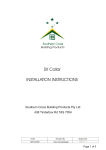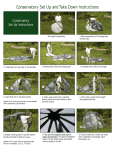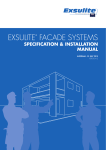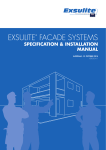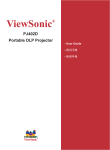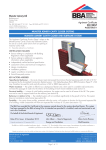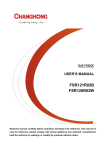Download January 2009 Installation manual
Transcript
SCBP SX Termite Collar Southern Cross Building Products Pty Ltd 438 Tinderbox Rd TAS 7054 Freecall 1300 929 626 Fax 03 6229 6383 Email: [email protected] www.scbp.com.au Last revised - March 2013 E. Bain Page 1 of 8 Description SX Termite collar is an injection moulded “collar” which is designed to deter concealed termite entry to structures via the shrinkage crack formed between the concrete slab and pipe penetrations. The collar is made of hardened UPVC - D80 hardness (instantaneous); at least 1mm thick, equivalent or higher grade than UPVC drainage pipes. Uses SX Termite collar is fitted to single pipe penetrations in concrete slabs. Sx termite collar should not be used for ‘clusters’or pipes close to the edge of a slab where the collar cannot be fully embedded in concrete. Ref to the limitations page. Packaging Features 100mm 80mm 50mm 40mm 200 collars / ctn 70 collars / ctn 50 collars / ctn 65 collars / ctn Hardened PVC - does not rely on a depleting pesticide Sx Termite collars are moulded from quality virgin PVC. The Australian compound supplier certifies the hardness of the compound, regular quality control tests of the finished collars confirms the hardness. Pest controllers, home owners and commercil asset owners can be confident that the collars are manufactured to last the life pof the building without relying on depleting pesticides. Last revised - March 2013 E. Bain Page 2 of 8 Features SX Collars are a deemed to satisfy product for AS 3660.1 SX Termite collars are a deemed to satisfy product under AS 3660.1 “Section 3.3 Structural elements below Termite Barriers All structural elements below the termite barriueror any penetration through a structural element or in contact with the ground shall be termite resistant. The following materials shall be deemed to be termite resistant..... (f) Unplasticised Poly (vinyl chloride) (PVC) - having a minimum thickness of 1mm and a minimum hardness shore D 80 (instantaneous)” SX collars are Codemark Approved Last revised - March 2013 E. Bain Page 3 of 8 Features Strong & Compact design SX Termite collars are made using hardened PVC. This high strength compound allows the collars to be a small strong design. Ribs to cast into concrete Friction pad Main flange Last revised - March 2013 E. Bain Taper& thickening for strength Page 4 of 8 Features continue... Easy Installation SX Collars are easy to install. The compact size ensures the collar will easily embed in the concrete. Other collars with large flanges or upstand may not embed properly in the slab; they may interfere with steel work or even require structural steel to be removed to fit the collar. SX termite collars are designed as a press fit collar. No gluing. The collars are easily located just above or below the steel work so the collars can be installed anytime up until the concrete is poured. Other collars need to be scheduled to fit in with the concretors work. Sx Termite collars key strongly into the concrete to block termite access. Other collars placed low in the slab may not properly embed in the concrete Last revised - March 2013 E. Bain Other collars with high ‘upstands’ can protrude above FFL (finished floor level). Page 5 of 8 Installation - Waffle Pod Ground Works A building site generally commences with preparing the site. This involves removing vegetation, protruding rocks debris including old timbers or tree stumps. The site is levelled and footings including pier holes are dug. External Drainage The plumber digs trenches and lays the pipes which will carry away sewerage and waste or ‘grey water’ from the house. These pipes are usually UPVC or polypropylene. The pipes are left sticking up out of the ground, to stop debris falling down the pipes a cap or tape is placed over the open ends. Plastic membrane;waffle pods and steel mesh ... The concretors place the moisture barrier, waffle pods (if required) and steel mesh. The mesh is held up on ‘bar chairs’ above the pods. Collars are fitted at this time Do not fit the collars before the waffle pods as they could easily be covered by the pod (not cut through and therefore not encased in concrete. Fit the collar - Remove the plastic cap or tape - Wipe off any mud or debris from the pipe. - Press the collar onto the pipe down to the level of the steel (at least 20mm below the top of the slab and 20mm above the bottom of the slab). Generally the steel will have 80mm of concrete cover above it. - Ensure that the flat surface marked “This side Down” is facing the ground and the ribbed side is facing up. - Ensure that the collar fits snugly and can easily bear its own weight, apply a pvc glue as required. The slab is poured The concretors pour the slab and the collars are cast in. Last revised - March 2013 E. Bain Page 3 of 5 Page 6 of 8 Installation - Raft Slab Ground Works Like waffle pod slabs, a raft slab commences with preparing the site. This involves removing vegetation, protruding rocks debris including old timbers or tree stumps. The site is levelled and footings including pier holes are dug. External Drainage The plumber digs trenches and lays the pipes which will carry away sewerage and waste or ‘grey water’ from the house. These pipes are usually UPVC or polypropylene. The pipes are left sticking up out of the ground, to stop debris falling down the pipes a cap or tape is placed over the open ends. Collars may be fitted at this time Alternatively wait until the plastic membrane and steel is fitted and install the collars in the same manner as for a waffle pod slab. Last revised - March 2013 E. Bain Page 7 of 8 LIMITATIONS The follow limitations apply to the installation of the collars: 1. The collar must only be used where the entire collar including the flange and thickened upstand can be fully embedded in the concrete slab. The collar should not be placed within 20mm of the top of the slab (FFL) or within 20mm of the bottom of the slab. The level or height of the collar placement within the slab is incidental provided the 20mm minimums top and botton are complied with. 2. The collar fit must be sufficiently tight so as to at least hold its own weight. 3. The Collar must not be fitted where it is so tight as to fracture or structurally weaken the flange. 4. The collar must not be fitted over damaged pipes, a visible scrape, crack or scoring in the pipe may compromise the bond. 5. Once installed the collars installation must be certified by the installer and regular inspections carried out in accordance with As3660.; and AS 3660.2 6. The collar must be fitted with the flange marked “This side down” facing the ground. The upper portion of the flange has the ribs, these face up and engage with the slab. 7. Pipe clusters must be able to be separated so as to allow the collar to be fully encased in concrete with at least 20mm clearance around the collar. If this separation is not possible another product should be considered. 8. Pipe lagging must be removed to allow the collar effective contact with the pipe. The lagging may be replaced above and below the collar. 9. The installer shall record the details of the installation on a certificate of installation so as to allow traceability of the collars. The Installation certificate shall comply to AS 3660.1 2000 Appendix A. These records shall be kept by the installer for a period of five (5) years. The process of recording installation data may be subject to independent review from time to time. 10. The collar is not to be installed north of the Tropic of Capricorn 11. The installer shall hold appropriate pest management training such as as Pest management Certificate 2 or above. The installer may use workers to install the collars under their supervision. Last revised - March 2013 E. Bain Page 8of 8








